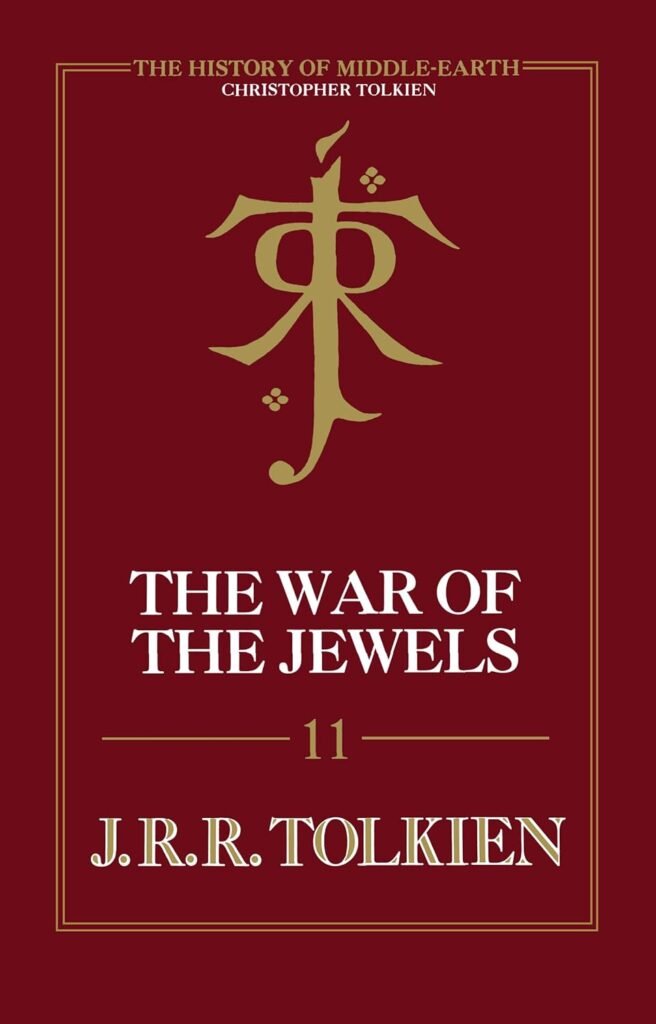History of Middle-Earth, Part 5 – The Later Silmarillion

Tolkien After The Lord of the Rings
By the time Tolkien completed The Lord of the Rings in 1949, he had poured more than a decade of his life into the tale of hobbits, kings, and the fate of the One Ring. Most authors would have been content to rest on such an achievement. Tolkien, however, was not finished. If anything, the epic had only deepened his desire to return to the older, grander mythologies he had begun decades earlier—the vast story of the First Age, the struggles against Morgoth, and the tragic fates of Elves and Men.
His work in the years after The Lord of the Rings was not focused on new adventures but on revising, expanding, and philosophically deepening The Silmarillion. This period is captured in Volumes 10 and 11 of The History of Middle-Earth: Morgoth’s Ring and The War of the Jewels. Together, they show Tolkien wrestling with profound questions of theology, mortality, and the nature of evil.

Volume 10: Morgoth’s Ring (1993)
The title of this volume is significant. Just as the One Ring embodies Sauron’s power, Morgoth’s Ring suggests that Morgoth, the first Dark Lord, poured his essence into the very fabric of Arda itself. Evil was no longer confined to one being; it had seeped into the world, a permanent corruption. Some of the key texts in this volume include,
- The Later Ainulindalë – new versions of the creation story, more philosophical and metaphysical than ever before.
- The Later Quenta Silmarillion – revisions of the great narrative of the First Age.
- Athrabeth Finrod ah Andreth – a dialogue between the Elf Finrod and the mortal woman Andreth, meditating on mortality, immortality, and the fate of Men.
- Myths Transformed – essays in which Tolkien reflects on cosmology, evil, and the metaphysical nature of Arda.
Why It Matters
Morgoth’s Ring reveals Tolkien at his most philosophical. The Athrabeth, in particular, is one of the most profound texts he ever wrote. It explores the sorrow of Men doomed to die, the envy of the Elves bound to the world, and the mysterious hints of a greater destiny for humanity beyond Arda.

Volume 11: The War of the Jewels (1994)
If Morgoth’s Ring focuses on the cosmology and theology of Arda, The War of the Jewels turns back to the history of the First Age, especially the wars in Beleriand. Some of the key texts in this volume include,
- The Later Annals of Beleriand – a detailed chronology of the wars against Morgoth.
- The Later Quenta Silmarillion – revised narratives of the great tales, including Beren and Lúthien and the Children of Húrin.
- The Grey Annals – a more structured and continuous history of the First Age.
- Athrabeth-related Writings – expansions on the themes of mortality and the fate of Elves and Men.
Why It Matters
This volume shows Tolkien’s painstaking effort to bring order and structure to his sprawling mythology. The Annals are particularly significant—they transform scattered tales into a chronological framework that reads like a true history. At the same time, the revisions show Tolkien wrestling with the tragic weight of his stories: the pride of the Noldor, the sorrow of Túrin, the beauty and sacrifice of Lúthien.
A Mature Vision of Myth
What sets these two volumes apart is their tone. The early Book of Lost Tales had a whimsical, fairy-tale quality. The Lays of Beleriand reveled in poetic grandeur. But the later Silmarillion writings are something else entirely: sober, philosophical, and tragic.
Tolkien was no longer the young soldier scribbling myths after the Somme. He was an older man, deeply aware of mortality, wrestling with ultimate questions. His mythology had grown into a framework for exploring the human condition.
Christopher Tolkien’s Role
As always, Christopher Tolkien was the steward of these writings. His editorial notes in Morgoth’s Ring and The War of the Jewels are extensive, guiding readers through a labyrinth of drafts, variants, and abandoned fragments. It is a remarkable act of scholarship, without which these texts would remain indecipherable to all but the most dedicated specialists.
Christopher often lamented that his father never completed The Silmarillion in the form he envisioned. But through these volumes, we can see just how close Tolkien came, and how ambitious his vision truly was.
Why These Volumes Matter
For readers of The Silmarillion, these later volumes add immense depth. They show us not just the stories but the meaning behind them—the theology of creation, the nature of evil, the destiny of humanity. They transform the legendarium from mythic storytelling into something approaching a philosophy of history.
They also remind us that Tolkien’s work was never static. He was always revising, rethinking, and expanding. Middle-Earth was alive for him until the end of his life.
Looking Ahead
With Morgoth’s Ring and The War of the Jewels, Tolkien had reached the pinnacle of his myth-making. But one more stage remained. In his final years, he turned to questions of peoples, languages, and metaphysics—writing about the details of Elves, Men, Dwarves, and the very nature of time and being.
In Part 6, we will explore the closing volumes: The Peoples of Middle-Earth and The Nature of Middle-Earth. These works complete the great puzzle of Tolkien’s legendarium, offering us a last glimpse into his creative mind and the legacy carried forward after his death.
Other posts in the series
- History of Middle-Earth, Part 1 – The Birth of a Legendarium
- History of Middle-Earth, Part 2 – The First Five Volumes: Early Myths & Lost Tales
- History of Middle-Earth, Part 3 – The Road to Númenor and the Shaping of History
- History of Middle-Earth, Part 4 – The Making of The Lord of the Rings
- History of Middle-Earth, Part 5 – The Later Silmarillion
- Part 6, coming October 30
Bibliography
- History of Middle Earth, Vol. 1: The Book of Lost Tales, Part I Kindle Paperback
- History of Middle Earth, Vol. 2: The Book of Lost Tales, Part II Kindle Paperback
- History of Middle Earth, Vol. 3: The Lays of Beleriand Kindle Paperback
- History of Middle Earth, Vol. 4: The Shaping of Middle-earth Kindle Paperback
- History of Middle Earth, Vol. 5: The Lost Road and Other Writings Kindle Paperback
- History of Middle Earth, Vol. 6: The Return of the Shadow Kindle Paperback
- History of Middle Earth, Vol. 7: The Treason of Isengard Kindle Paperback
- History of Middle Earth, Vol. 8: The War of the Ring Kindle Paperback
- History of Middle Earth, Vol. 9: Sauron Defeated Kindle Paperback
- History of Middle Earth, Vol. 10: Morgoth’s Ring Kindle Paperback
- History of Middle Earth, Vol. 11: The War of the Jewels Kindle Paperback
- History of Middle Earth, Vol. 12: The Peoples of Middle-earth Kindle Paperback
- History of Middle-Earth Index Paperback
- The Complete History of Middle-Earth Box Set Hardcover
- History of Middle-Earth Box Set#1 Hardcover
- History of Middle-Earth Box Set#2 Hardcover
- History of Middle-Earth Box Set#3 Hardcover
- History of Middle-Earth Box Set#4 Hardcover
- The Nature of Middle-Earth Kindle Paperback Hardcover
👁️ 15 views

